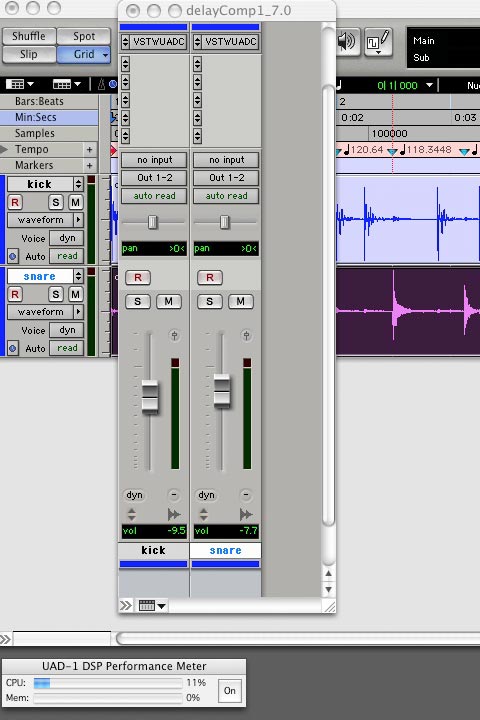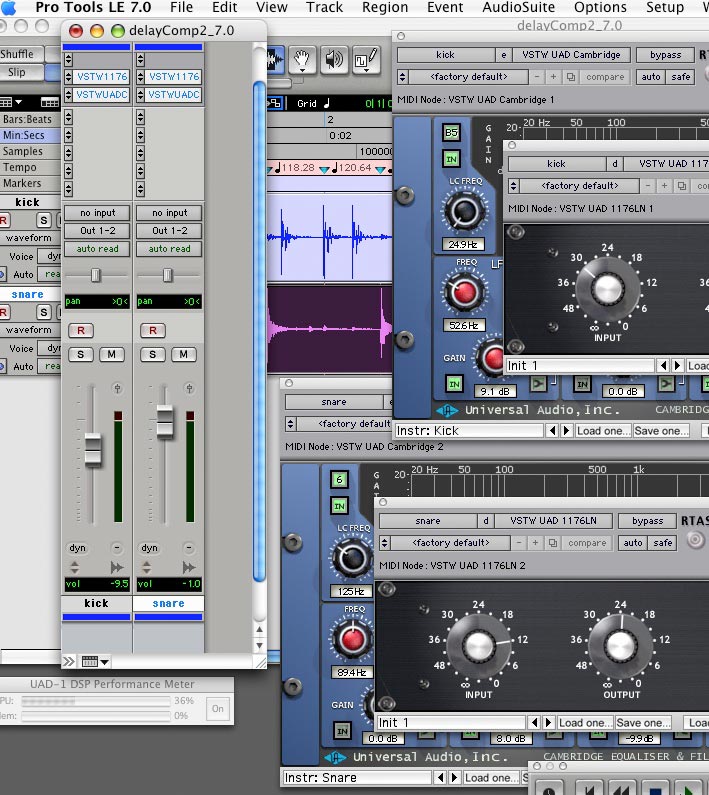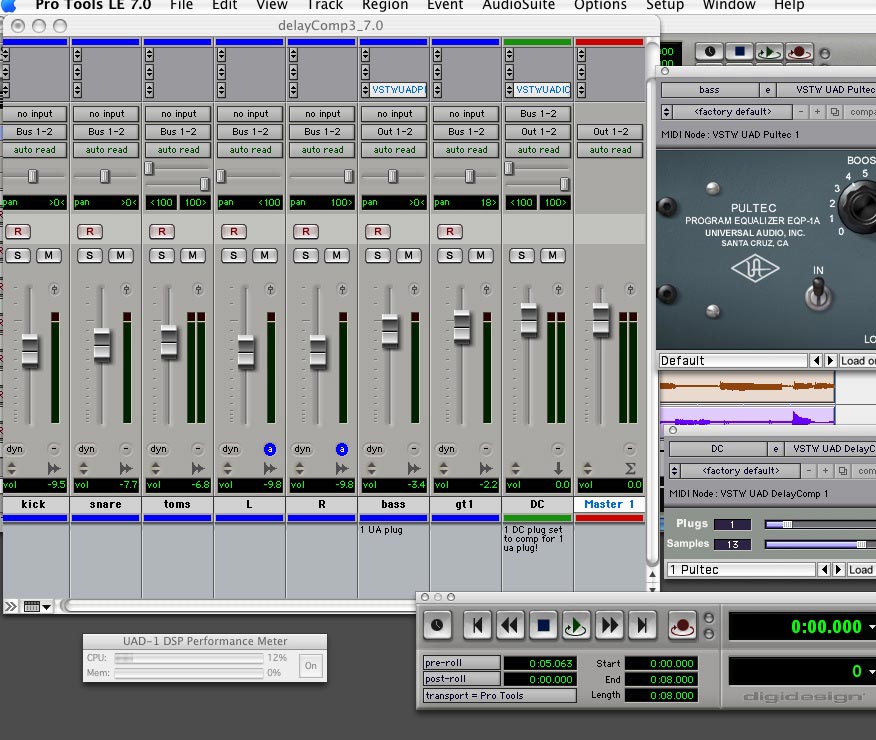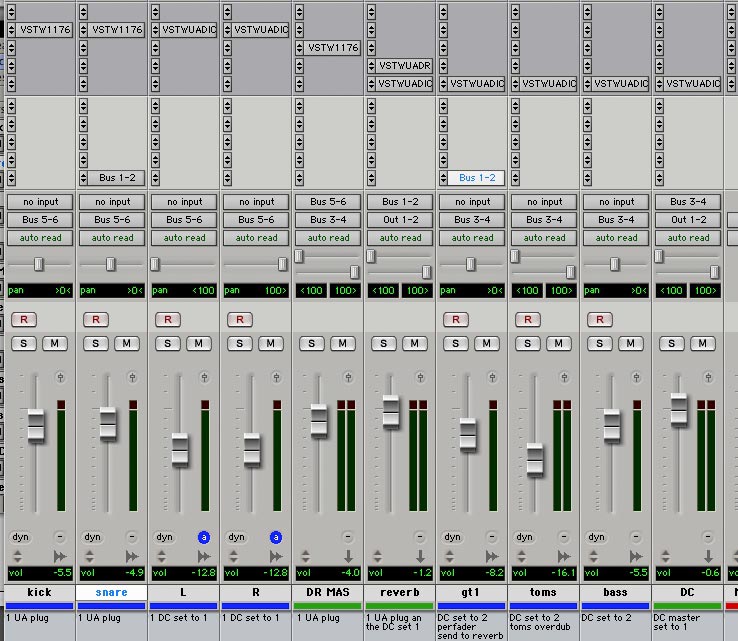Support Report: Pro Tools LE & UAD-1 Using Delay Comp
By Casey Schultheis
Right now, Pro Tools LE and Pro Tools M-Powered are the only major DAW applications that do not have automatic plug-in delay compensation (also known as "PDC"). To compensate for latency introduced by using the UAD-1 plug-ins, use the included "UAD Delay Comp" plug-in. This plug-in allows you to easily compensate for tracks without UAD-1 plug-ins on them so that they play in sync with the tracks that have UAD-1 plug-ins on them. There are five Pro Tools LE sessions available for download at the bottom of this article.
“This plug-in allows you to easily compensate for tracks without UAD-1 plug-ins on them so that they play in sync.”
 |
|
DC1
|
DC1: In the first example we have two mono audio tracks with one UAD-1 1176LN plug-in on each audio track. Because both audio tracks are being delayed by the same amount and there are no other audio tracks, the audio is in sync.
 |
|
DC2
|
DC2: In the second example, we have two mono audio tracks, each with two UAD-1 plug-ins. Because both audio tracks are being delayed the same amount and there are no other audio tracks, the audio is in sync.
 |
|
DC3
|
DC3: In this example, we have six mono audio tracks and one stereo audio track with 1 UAD-1 Pultec plug-in on the bass track. All other audio track's main outputs are routed to bus 1/2. We also have one stereo buss track where we have a Delay Comp plug set to compensate for 1 plug-in and 13 samples. Because the UAD Pultec and UAD Pultec-Pro equalizers use an internal sample rate of 192kHz to achieve their magic quality, this up-sampling results in a slightly larger latency than other UAD-1 plugins. Therefore, these plug-ins require slightly more compensation to remain perfectly synchronized with other tracks. Specifically, they require an extra 13 samples of compensation when the session sample rate is below 100kHz.
 |
|
DC4
|
DC4: In this example, we have six mono audio tracks and one stereo audio track with one UAD-1 plug-in on each audio track, and the main outputs are routed to the DC bus. We also have one guitar track with one prefader send to a stereo aux track with one UAD-1 reverb and the output as well sent to the DC bus. Because all audio tracks are being delayed the same amount the audio is in sync.
 |
|
DC5
|
DC5: In this example, we have six mono audio tracks and one stereo audio track. We also have two tracks with one prefader send to a stereo aux track with one UAD-1 reverb. Let's work from left to right. The kick with one UA plug, snare with one UA plug and both the Left and Right overheads have a Delay Comp plug set to compensate for one plug-in. All of the four drum tracks are sent to a Drum Master. There is an 1176LN on the Drum Master, and the output is sent to the DC bus. Next we have reverb bus input 1/2 with one UA reverb and one Delay Comp set to 1. There is one delay comp plug on the Guitar track set to 2 and a prefader send to a stereo aux reverb track, and the output is sent to the DC bus. The toms have one Delay Comp plug set to 2 and output sent to the DC bus. The Bass track has one Delay Comp plug set to 2 and output sent to the DC bus. The DC bus has one Delay Comp plug set to 2 and its output is sent to the master output 1/2.
All technical support for the adapter is handled by FXpansion. FXpansion's website features a support email address and an online forum for support and exchange of tips and information with other VST-RTAS users, moderated by FXpansion.
Here are some great articles from previous WebZines about using delay compensation with the UAD-1 card and different host applications.
- Using the UAD-1 in Pro Tools HD and Automatic Delay Compensation
- Introducing UAD-1 Support for RTAS
- VST-RTAS Adapter
Pages 43 through 53 in the UAD-1 manual should also answer many questions you may have about Delay Compensation.
Download an example ProTools DelayComp Session